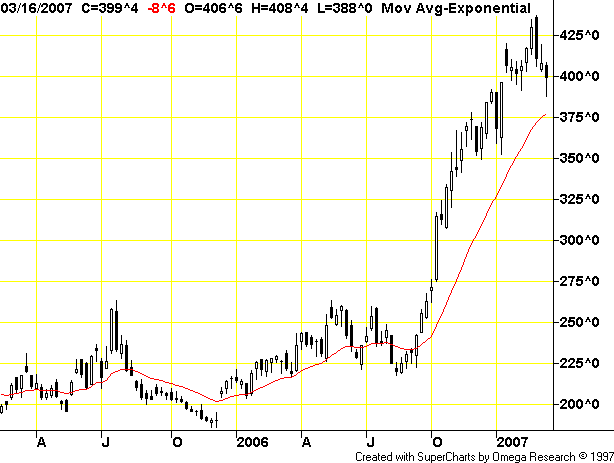By Bonddad
bonddad@prodigey.net
On Saturday I wrote an article titled Why Are Food Prices Spiking? In that article, I noted that agricultural prices are spiking and noted a basic drop in supply and increase in demand. This article follows up on that, especially in regards to how the development of the ethanol market is playing agricultural prices spikes.
I would also like to point out that I am not the only person who has written on this. Many other writers have pointed this out. Simply do a search under ethanol and you will find many well-written and informed articles.
From the blog, Financial Sense
Thanks to Federal mandates and subsidies, corn used for the production of corn ethanol is expected to increase from ~ 700 M Bushels in 2000/2001, to 3.2 B bushels in 2007/2008 – an increase of 357 percent. On December 11, 2006, the USDA estimated 2006-2007 U.S. ending stocks would be 935 million bushels, down from 1.97 billion bushels in 2005-2006. That decreases the ending stocks by more than 50 percent and puts the ending stocks to use ratio at 8%, - the lowest in 11 years. It should be obvious to all, we are going to need a lot more acreage and big yield improvements if corn production is going to keep up to demand. Prices could exceed $4.50 per Bu by the end of 2008. That’s a price increase of 125% over 2005/2006 season prices.
Let's take this one point at a time.
corn used for the production of corn ethanol is expected to increase from ~ 700 M Bushels in 2000/2001, to 3.2 B bushels in 2007/2008 – an increase of 357 percent.
In other words, demand hasn't just increased; it has spiked off the map. Econ 101: increased demand equals increased price.
On December 11, 2006, the USDA estimated 2006-2007 U.S. ending stocks would be 935 million bushels, down from 1.97 billion bushels in 2005-2006. That decreases the ending stocks by more than 50 percent
Supply is contracting as well, and not by a little. By a lot. Econ 101: decreased supply = increased price.
It should be obvious to all, we are going to need a lot more acreage and big yield improvements if corn production is going to keep up to demand. Prices could exceed $4.50 per Bu by the end of 2008. That’s a price increase of 125% over 2005/2006 season prices.
Yes we are. The problem is the total amount a acreage devoted to corn farming is decreased. Accordiing to the Department of Agriculture the US produced 299.91 million metric tons n 2004 and is projected to produce 267.60 million metric tons as of March 2007. That's a drop of 11%. Also remember that demand has increased by 357%. That explains why corn futures have soared.
And it's not just corn that's increasing in price. Remember corn is a basic ingredient in a ton of food.
If corn prices increase by ~ 55 percent, year over year, then will the corn used for hog, cattle, chicken, turkey and fish feed go up 55 %? Doesn’t that increase the price of meat, poultry, fish, milk and eggs? If corn is used in corn meal, corn flakes, corn oil, and hundreds of other food items goes up 55%, doesn’t that increase the price of all these foods? Maybe. Since 2000, the price of beef is up 31%, eggs up 50%, corn sweeteners up 33%, wet corn milling up 39%, and corn flakes are up 10%. Chicken prices haven’t changed very much. Yet. Food producers are predicting higher prices.
There's a ripple effect through the entire food production change because of increased corn demand.
The author goes on to discuss the political situation with the corn industry and offers better solutions. I'm not scientifically qualified to say yeah or nay on any of these ideas (Damn it, Jim! I'm an economist, not a scientist).
However, I can say with certainty that if the current situation holds we have some really big possible problems coming up. These are the observations I made before and they still hold true:
1.) Inflationary pressures. Last year oil was the big inflation boogie-man. Now food prices may take their place. The charts above show the food prices are spiking. With overall production down over the last three years and a projected lower production level this year supply won't pick-up until next year. That means food based inflationary pressures may be with us for at least another year.
Also remember that agricultural prices in CPI and PPI have increased over the past three months at very high rates. I am sure the Fed will be discussing these increases at their meeting today.
2.) Higher inflationary pressures means the Fed will be less inclined to lower interest rates. If the economy continues to slow, the Fed won't be able to provide monetary stimulus. That could exacerbate an economic slowdown.
3.) The economy has been growing for the 2004-2007 time period, yet food production is down. There may be a bigger problem lurking here.
The short version is out dependence on corn may wind up creating a really big problem in the future.
One final note. I am not endorsing nor condoning the ethanol program. I'm not qualified to make a recommendation one its veracity on way or the other.
For economic commentary and analysis, go to the Bonddad Blog

No comments:
Post a Comment